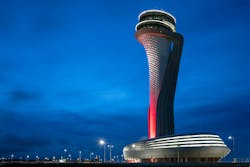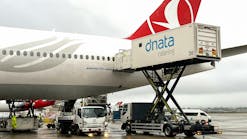The Sky’s the Limit in Istanbul After the Great Move
In April, trucks moving together in a synchronized caravan transported 50,000 tons of equipment (including 11,833 pieces of GSE) from Ataturk International Airport (ISL) to Istanbul Airport (IST) in just 45 hours.
News reports describe it as a true logistical masterpiece. Though the airports lie just 26 miles apart, trucks covered an estimated 248,549 miles as they made thousands of journeys between the two facilities. In addition, 146 Turkish Airlines (THY) aircraft also made the transfer.
Twelve hours after the “great move,” the first Turkish Airline flights took off at the $12 billion airport.
“We believe coordination and communication were key to completing the successful move,” report officials for iGA Istanbul, the consortium that won the concession to build and manage Istanbul’s mega airport for 25 years.
Planning what Turkish Airlines chairman Ilker Ayci has called “the biggest move in aviation history” involved organizing more than 100 meetings and workshops with stakeholders and government agencies to examine the details of the GSE transfer. The airport works with three primary ground support stakeholders: Turkish Ground Services (TGS), Havas Ground Handling Co. and Celebi Ground Handling Company. It also hired three separate logistics firms to move equipment. Arkas Logistic Company moved equipment for Turkish Airlines and TGS, Hareket Logistic Company moved Celebi units, and Istanbul Agir Nakliyat moved Havas GSE.
“For the transfer plan, we studied in detail each vehicle movement from ISL to IST in 15-minute movement windows. From there we developed the Transfer Logistics Plan with details for each vehicle and its cargo,” say iGA officials.
The airport organized transfer trials before the “Big Bang,” as the move was also called.
“We paid special attention to safety planning around the loading and unloading areas to ensure safe and quick handling of the equipment, which was key to achieving delivery rates that met the Transfer Logistics Plan,” note iGA officials.
iGA coordinated the transfer from three centers and set up a strong communications plan to ensure all movement went smoothly.
“In order to meet the requirements of passing from airside to airside, we set up a secure corridor, using the new highway connection between Ataturk Airport and Istanbul Airport. This corridor was monitored by police and security teams to allow trucks to pass from airport to airport, without further security inspection, to speed up the unloading process,” iGA officials add.
Some of the equipment was too large to pass through highway toll stations. The airport set up an alternate route to deliver those vehicles.
Havas moved approximately 600 pieces of GSE to Istanbul Airport, leaving a portion of its equipment at Ataturk for general aviation flights and freight operations. The responsibility of moving equipment fell to ground handlers. But Mete Erna, sales and marketing director for Havas, reports the process was “successfully completed thanks to the perfect cooperation among ground handlers, authorities and logistics services suppliers.”
“Havas moved its facilities at Ataturk to the new airport within 30 hours, less than the planned timing, by using 186 trucking rigs to transport its equipment,” Erna points out.
Larger than Life
Everything is larger than life at the new airport, not just the size of the move.
IST or “Istanbul New” is the city’s third international airport. The old airport remains open for cargo and VIP flights, while all other passenger flights will take off from what is known in some circles as the “world’s new hub.”
The new facility is a long time coming. Construction began in 2015, after it was determined the area required more air capacity serving Istanbul; and neither Ataturk nor Sabiha Gökçen Airports could grow to meet demand. Ataturk was already serving more passengers than its design capacity allowed, and its location did not allow for further expansion. The lack of space also meant IST could not accommodate Airbus A380s, making it the only large airport in Europe and the Middle East that could not.
“We strive to make Istanbul the aviation capital of the world, and take aviation into the future,” iGA officials state. “Istanbul Airport is the key to that achievement. We want to redefine travel by making Istanbul Airport a beacon of passenger experience and a travel destination. Also, our objective is becoming an airport that is top choice among airline companies.”
The new airport sets the region on this path by resolving the limitations experienced at Ataturk. Initially, it will serve an estimated 90 million passengers annually from two runways. It will eventually expand to six runways and 16 taxiways when all phases are complete. A Metrolink will connect the airport to central Istanbul in 2020.
This will rank it ahead of Atlanta Hartsfield-Jackson International (ATL), which – as the world’s largest airport today – serves 104 million passengers a year.
“For the short term, our goal is to become the second busiest airport in the world after Atlanta in the next two to four years and surpass Atlanta as the busiest airport in the world, when all phases are complete,” iGA officials explain.
The new airport is also the largest in square footage. At 818 million square feet, it is 3½ times the size of the 250-million-square-foot Beijing Capital International.
The facility invested in 143 passenger boarding bridges from thyssenkrupp, 147 ITW Axa Power fixed ground power units (GPUs), 114 ITW Axa Power pre-conditioned air (PCA) system units with thyssenkrupp automatic hose retrievers and 114 ADB Safegate visual docking guidance systems for contact gates.
In addition, there is a 42-mile Vanderlande baggage system, which can process 10,800 pieces of baggage, gathered from 13 check-in islands. There is also an early baggage storage system available to store baggage that arrives early.
Cutting-edge technology also includes smart wayfinding systems to help passengers move through the terminal. Facial recognition accelerates passenger control and a new baggage system delivers luggage quickly. The Internet of Things (IoT) provides an overview of airport systems to help crews respond quickly to problems. Nine-thousand, state-of-the-art security cameras keep an eye on operations inside and out.
“All companies were responsible for the design, installation, testing and commissioning of these systems,” report iGA officials. “All processes have been running well [since moving in]. With every measure we take we want to ensure that these processes continue to run perfectly to provide the best possible and most comfortable passenger experience.”
An Upsize in Ground Handling
Ground handlers also upsized their operations to accommodate future traffic.
Havas reports making substantial investments. The company spent $23.5 million on a new cargo warehouse, GSE workshop, ramp and administration buildings.
“The bulk of our GSE investments consisted of passenger stairs, baggage tractors, dollies, water and lavatory trucks, due to the increase in the area on which we run our operations,” says Erna. “We have doubled the capacity of our facilities at the new airport, compared to Ataturk. Our new facilities cover approximately 430,556 square feet, including a 215,278-square-foot indoor area.”
Havas also increased the size of its station building, equipment maintenance workshop and parking areas at the new airport.
Full Steam Ahead
“Global aviation is growing rapidly and Istanbul Airport offers outstanding opportunities to accommodate that growth,” state iGA officials.
The airport is well situated geographically to attract new airlines. It also has state-of-the-art infrastructure that allows airlines to grow.
The airport aims to be a top choice among airlines, currently 70 airlines service Istanbul Airport and eight foreign airlines have begun to fly from IST for the first time since it reached capacity. These airlines include Ethiopian Airlines, Nouvelair, Indigo, Air Albania, Sichuan Airlines, China Southern, Tassili Airlines and UR Airlines. Two more airlines will begin flight operations soon.
With the full capacity of Istanbul Airport, airlines from Europe, the Middle East, Africa and the Far East have also increased their frequencies.
Other airlines are expanding their connections to Istanbul Airport by flying larger aircraft. Singapore Airlines, which operated five weekly flights with Boeing 777-200 J aircraft, will operate the next generation of Airbus 350-900, beginning in December. With this change, the airline will increase its initial business class by 62 percent. Sichuan Airlines also converted its A330-200 flights to A350 aircraft to increase its seat capacity by approximately 10 percent.
Havas sees good times ahead as the airport continues to expand operations. In fact, the ground handler has already seen an increase in contracts.
“The move to Istanbul Airport covered the transfer of existing flights only,” states Erna. “However, the increased capacity at the new airport allows new carriers to operate flights to Istanbul. We’ve already started to receive new contracts from operators starting new service. We expect more carriers to launch flights to Istanbul once the third runway is complete in 2020.”
Erna admits this has prompted Havas to hire and train more personnel.
“We also put effort into maintaining our existing workforce under the strain of relocating to the new airport,” Erna says. “There are new employment opportunities as well. We currently have 1,200 employees working at the airport and plan to gradually increase this number.”
Havas also has increased its training investment.
“We provided training on the new apron and terminal areas, new smart airport systems and equipment,” Erna reports. “We also provide equipment training with our simulator as part of our training policy. In addition, we support sustainable efficiency by providing regular refresher training with continuously updated training contents at all stations in Turkey, Latvia and Saudi Arabia.”




